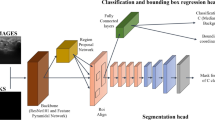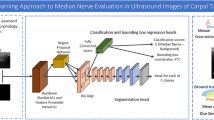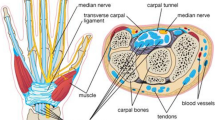Abstract
Purpose
Carpal tunnel syndrome (CTS) is characterized anatomically by enlargement of the median nerve (MN) at the wrist. To better understand the 3D morphology and volume of the enlargement, we studied its volume using automated segmentation of ultrasound (US) images in 10 volunteers and 4 patients diagnosed with CTS.
Method
US images were acquired axially for a 4 cm MN segment from the proximal carpal tunnel region to mid-forearm in 10 volunteers and 4 patients with CTS, yielding over 18,000 images. We used U-Net with ConvNet blocks to create a model of MN segmentation for CTS study, compared to manual measurements by two readers.
Results
The average Dice Similarity Coefficient (DSC) on the internal and external validation datasets was 0.82 and 0.81, respectively, and the area under the curve (AUC) was 0.92 and 0.88, respectively. The inter-reader correlation DSC was 0.83, and the AUC was 0.98. The correlation between U-Net and manual tracing was best when the MN was near the surface. A US phantom mimicking the MN, imaged at varied scanning speeds from 7 to 45 mm/s, showed the volume measurements were consistent.
Conclusion
Our AI model effectively segmented the MN to calculate MN volume, which can now be studied as a potential biomarker for CTS, along with the already established biomarker, cross-sectional area.






Similar content being viewed by others
Data availability
The data that support the findings of this study are not openly available due to reasons of sensitivity related to patient confidentiality and protected intellectual property, but are available, as permitted by law, from the corresponding author upon reasonable request. Data are located in controlled access data storage at Mayo Clinic.
References
Tsamis, K. I., Kontogiannis, P., Gourgiotis, I., Ntabos, S., Sarmas, I., & Manis, G. (2021). Automatic electrodiagnosis of carpal tunnel syndrome using machine learning. Bioengineering (Basel). https://doi.org/10.3390/bioengineering8110181
Wong, S. M., Griffith, J. F., Hui, A. C. F., Lo, S. K., Fu, M., & Wong, K. S. (2004). Carpal tunnel syndrome: DIAGNOSTIC usefulness of sonography. Radiology, 232, 93–99.
Hosseini-Farid, M., Schrier, V. J. M. M., Starlinger, J., & Amadio, P. C. (2021). Carpal tunnel syndrome treatment and the subsequent alterations in median nerve transverse mobility. Journal of Ultrasound in Medicine, 40, 1555–1568.
Mooar, P. A., Doherty, W. J., Murray, J. N., Pezold, R., & Sevarino, K. S. (2018). Management of carpal tunnel syndrome. Journal of American Academy of Orthopaedic Surgeons, 26, e128–e130.
Fowler, J. R., Gaughan, J. P., & Ilyas, A. M. (2011). The sensitivity and specificity of ultrasound for the diagnosis of carpal tunnel syndrome: A meta-analysis. Clinical Orthopaedics & Related Research. https://doi.org/10.1007/s11999-010-1637-5
Fowler, J. R., Hirsch, D., & Kruse, K. (2015). The reliability of ultrasound measurements of the median nerve at the carpal tunnel inlet. The Journal of Hand Surgery. https://doi.org/10.1016/j.jhsa.2015.07.010
Gonzalez-Suarez, C. B., Buenavente, L. D., Cua, R. C. A., Fidel, M. B. C., Cabrera, J.-T.C., & Regala, C. F. G. (2018). Inter-rater and intra-rater reliability of sonographic median nerve and wrist measurements. Journal of Ultrasound, 26, 14–23.
Ghasemi-Esfe, A. R., Khalilzadeh, O., Vaziri-Bozorg, S. M., Jajroudi, M., Shakiba, M., Mazloumi, M., et al. (2011). Color and power Doppler US for diagnosing carpal tunnel syndrome and determining its severity: A quantitative image processing method. Radiology, 261, 499–506.
El Miedany, Y., El Gaafary, M., Youssef, S., Ahmed, I., & Nasr, A. (2015). Ultrasound assessment of the median nerve: A biomarker that can help in setting a treat to target approach tailored for carpal tunnel syndrome patients. Springerplus, 4, 13.
Sasaki, T., Nimura, A., Kuroiwa, T., Koyama, T., Okawa, A., & Fujita, K. (2022). Assessment of pain during nerve conduction studies in patients with carpal tunnel syndrome. Journal of Hand Surgery Global Online. https://doi.org/10.1016/j.jhsg.2021.12.004
Finsen, V., & Russwurm, H. (2001). Neurophysiology not required before surgery for typical carpal tunnel syndrome. The Journal of Hand Surgery: British, 26, 61–64.
Sasaki, T., Koyama, T., Kuroiwa, T., Nimura, A., Okawa, A., Wakabayashi, Y., et al. (2022). Evaluation of the existing electrophysiological severity classifications in carpal tunnel syndrome. Journal of Clinical Medical Research, 11, 1685.
Naranjo, A., Ojeda, S., Araña, V., Baeta, P., Fernández-Palacios, J., García-Duque, O., et al. (2009). Usefulness of clinical findings, nerve conduction studies and ultrasonography to predict response to surgical release in idiopathic carpal tunnel syndrome. Clinical and Experimental Rheumatology, 27, 786–793.
Buchberger, W., Schön, G., Strasser, K., & Jungwirth, W. (1991). High-resolution ultrasonography of the carpal tunnel. Journal of Ultrasound in Medicine. https://doi.org/10.7863/jum.1991.10.10.531
Yesildag, A., Kutluhan, S., Sengul, N., Koyuncuoglu, H. R., Oyar, O., Guler, K., et al. (2004). The role of ultrasonographic measurements of the median nerve in the diagnosis of carpal tunnel syndrome. Clinical Radiology, 59, 910–915.
Ziswiler, H.-R., Reichenbach, S., Vögelin, E., Bachmann, L. M., Villiger, P. M., & Jüni, P. (2005). Diagnostic value of sonography in patients with suspected carpal tunnel syndrome: A prospective study. Arthritis and Rheumatism, 52, 304–311.
Werner, R. A., & Andary, M. (2002). Carpal tunnel syndrome: Pathophysiology and clinical neurophysiology. Clinical Neurophysiology, 113, 1373–1381.
Richman, J. A., Gelberman, R. H., Rydevik, B. L., Hajek, P. C., Braun, R. M., Gylys-Morin, V. M., et al. (1989). Carpal tunnel syndrome: Morphologic changes after release of the transverse carpal ligament. J Hand Surg Am., 14, 852–857.
Bleecker, M. L., Bohlman, M., Moreland, R., & Tipton, A. (1985). Carpal tunnel syndrome: Role of carpal canal size. Neurology, 35, 1599–1604.
Nanno, M., Kodera, N., Tomori, Y., Hagiwara, Y., & Takai, S. (2017). Median nerve movement in the carpal tunnel before and after carpal tunnel release using transverse ultrasound. Journal of Orthopaedic Surgery, 25, 2309499017730422.
Momose, T., Uchiyama, S., Kobayashi, S., Nakagawa, H., & Kato, H. (2014). Structural changes of the carpal tunnel, median nerve and flexor tendons in MRI before and after endoscopic carpal tunnel release. Hand Surgery, 19, 193–198.
Ng, A. W. H., Griffith, J. F., Tsoi, C., Fong, R. C. W., Mak, M. C. K., Tse, W. L., et al. (2021). Ultrasonography findings of the carpal tunnel after endoscopic carpal tunnel release for carpal tunnel syndrome. Korean Journal of Radiology, 22, 1132–1141.
Ardakani, A. A., Afshar, A., Bhatt, S., Bureau, N. J., Tahmasebi, A., Acharya, U. R., et al. (2020). Diagnosis of carpal tunnel syndrome: A comparative study of shear wave elastography, morphometry and artificial intelligence techniques. Pattern Recognit Lett., 133, 77–85.
Park, D., Kim, B. H., Lee, S.-E., Kim, D. Y., Kim, M., Kwon, H. D., et al. (2021). Machine learning-based approach for disease severity classification of carpal tunnel syndrome. Science and Reports, 11, 1–10.
Ronneberger, O., Fischer, P., & Brox, T. (2015). U-Net: Convolutional networks for biomedical image segmentation. Lecture Notes in Computer Science. https://doi.org/10.1007/978-3-319-24574-4_28
Wang, Y.-W., Chang, R.-F., Horng, Y.-S., & Chen, C.-J. (2020). MNT-DeepSL: Median nerve tracking from carpal tunnel ultrasound images with deep similarity learning and analysis on continuous wrist motions. Computerized Medical Imaging and Graphics, 80, 101687.
Horng, M.-H., Yang, C.-W., Sun, Y.-N., & Yang, T.-H. (2020). DeepNerve: A new convolutional neural network for the localization and segmentation of the median nerve in ultrasound image sequences. Ultrasound in Medicine and Biology, 46, 2439–2452.
Wu, C.-H., Syu, W.-T., Lin, M.-T., Yeh, C.-L., Boudier-Revéret, M., Hsiao, M.-Y., et al. (2021). Automated segmentation of median nerve in dynamic sonography using deep learning: evaluation of model performance. Diagnostics (Basel). https://doi.org/10.3390/diagnostics11101893
Perazzi, F., Khoreva, A., Benenson, R., Schiele, B., & Sorkine-Hornung, A. (2017). Learning video object segmentation from static images. 2017 IEEE Conference on Computer Vision and Pattern Recognition (CVPR). https://doi.org/10.1109/cvpr.2017.372
Hochreiter, S., & Schmidhuber, J. (1997). Long short-term memory. Neural Computation, 9, 1735–1780.
Festen, R. T., Schrier, V. J. M., & Amadio, P. C. (2021). Automated segmentation of the median nerve in the carpal tunnel using U-Net. Ultrasound in Medicine & Biology. https://doi.org/10.1016/j.ultrasmedbio.2021.03.018
Mhoon, J. T., Juel, V. C., & Hobson-Webb, L. D. (2012). Median nerve ultrasound as a screening tool in carpal tunnel syndrome: Correlation of cross-sectional area measures with electrodiagnostic abnormality. Muscle and Nerve, 46, 871–878.
Hobson-Webb, L. D., Massey, J. M., Juel, V. C., & Sanders, D. B. (2008). The ultrasonographic wrist-to-forearm median nerve area ratio in carpal tunnel syndrome. Clinical Neurophysiology, 119, 1353–1357.
Kuroiwa, T., Jagtap, J., Starlinger, J., Lui, H., Akkus, Z., Erickson, B., et al. (2022). Deep learning estimation of median nerve volume using ultrasound imaging in a human cadaver model. Ultrasound in Medicine and Biology, 48, 2237–2248.
Taha, A. A., & Hanbury, A. (2015). Metrics for evaluating 3D medical image segmentation: Analysis, selection, and tool. BMC Medical Imaging, 15, 29.
Sugimoto, H., Miyaji, N., & Ohsawa, T. (1994). Carpal tunnel syndrome: Evaluation of median nerve circulation with dynamic contrast-enhanced MR imaging. Radiology, 190, 459–466.
Myers, R. R., Heekman, H. M., & Powell, H. C. (1985). Pathology of experimental nerve compression. Journal of Neuropathology and Experimental Neurology. https://doi.org/10.1097/00005072-198505000-00128
Padua, L., Pazzaglia, C., Caliandro, P., Granata, G., Foschini, M., Briani, C., et al. (2008). Carpal tunnel syndrome: Ultrasound, neurophysiology, clinical and patient-oriented assessment. Clinical Neurophysiology, 119, 2064–2069.
Dietterich, T. (1995). Overfitting and undercomputing in machine learning. ACM Computing Surveys. https://doi.org/10.1145/212094.212114
Cosmo, M. D., Chiara Fiorentino, M., Villani, F. P., Sartini, G., Smerilli, G., Filippucci, E., et al. (2021). Learning-based median nerve segmentation from ultrasound images for carpal tunnel syndrome evaluation. Conference Proceedings: Annual International Conference of the IEEE Engineering in Medicine and Biology Society, 2021, 3025–3028.
Yoshii, Y., Zhao, C., & Amadio, P. C. (2020). Recent advances in ultrasound diagnosis of carpal tunnel syndrome. Diagnostics (Basel). https://doi.org/10.3390/diagnostics10080596
Acknowledgements
We would like to thank the Mayo Clinic Department of Radiology for computational resources and the Department of Orthopedic for data collection.
Funding
Funding for this work was provided by Mayo Clinic and a grant from NIH/NIAMS (AR62613). NIH/NIAMS had no involvement in study design; in the collection, analysis, and interpretation of data; in the writing of the report; and in the decision to submit the article.
Author information
Authors and Affiliations
Contributions
Conceptualization: PA, BJE; Methodology: JMJ, JS, MHF, ZA and PA; Software: JMJ, ZA, BJE; Visualization: All; Formal Analysis: JMJ and TK; Investigation: JS, MHF and ZA; Data Curation: JMJ, TK, JS, MHF and HL; Writing – Original Draft Preparation: JMJ; Writing – Review & Editing, all.; Project Administration: PA and BJE.
Corresponding authors
Ethics declarations
Conflict of interest
There are no conflicts of interest to declare.
Consent for Publication
Not applicable.
Consent to Participate
All research subjects were consented to an approved IRB protocol by a research study coordinator not otherwise involved in this project.
Ethical Approval
This study was approved by our institutional review board.
Supplementary Information
Below is the link to the electronic supplementary material.
Rights and permissions
Springer Nature or its licensor (e.g. a society or other partner) holds exclusive rights to this article under a publishing agreement with the author(s) or other rightsholder(s); author self-archiving of the accepted manuscript version of this article is solely governed by the terms of such publishing agreement and applicable law.
About this article
Cite this article
Jagtap, J.M., Kuroiwa, T., Starlinger, J. et al. AI for Automated Segmentation and Characterization of Median Nerve Volume. J. Med. Biol. Eng. 43, 405–416 (2023). https://doi.org/10.1007/s40846-023-00805-z
Received:
Accepted:
Published:
Issue Date:
DOI: https://doi.org/10.1007/s40846-023-00805-z




